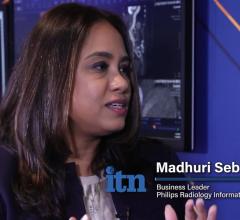
Grid computing conducts data mining, demonstrating how medical imaging is a driver for evidence-based medicine.
The challenge for secure, reliable and interoperable image management is multifaceted. With the emergence of RHIOs (regional healthcare information organizations), image management will move beyond a single PACS solution. The reality is that most health systems, like RHIOs, do not utilize one vendor for all PACS installations. So, how do users of different PACS share data?
Fathers of the Grid
Grid computing has emerged as a possible technology solution. However, other than a few large-scale projects, Grid computing is relatively untapped in healthcare. Unlike conventional networks that focus on communication among devices, Grid computing harnesses unused processing cycles of all computers in a network for solving problems too intensive for any stand-alone machine.
The idea of a Grid was propelled by Ian Foster, Carl Kesselman and Steve Tuecke, called the “fathers of the Grid.” Together, they led an effort to create the Globus Toolkit, which incorporates CPU and storage management, security provisioning, data movement and monitoring, plus a toolkit for agreement negotiation, notification mechanisms, trigger services and information aggregation.
Today the Globus Alliance, a group of organizations and individuals dedicated to developing technologies behind the “Grid,” maintains and updates the Globus Toolkit, an open source software toolkit for building Grid systems and applications2. For a Grid to be successful, it is dependent upon open-source architecture, or the Open Grid Services Architecture (OGSA), and is standards based.
Version 4 of the Globus Toolkit, a Web services-oriented platform, signaled the readiness of grid computing for mainstream enterprise applications.
Grid computing in healthcare
One of the more notable uses of Grid computing in healthcare is the MammoGrid project. Supported by the European Union Information Societies Technology (IST) Programme, the project developed a European-wide database of mammograms to investigate various applications against different subsets of the population as well as evaluate the potential of the Grid to facilitate communication and cooperation between healthcare professionals throughout the continent.
Although the project ended in August 2005, the group was successful in creating a prototype software that enabled healthcare providers to share resources and utilize the massive capacity of Grid computing for processing advanced algorithms on digital mammograms.
A new consortium independent of IST funding has continued the project with four separate sites that simulate the needs of four different hospitals to test the project’s latest developments. According to David Manset of Maat GKnowledge (Madrid, Spain), results have been evaluated by a panel of two IT experts and five clinicians from hospitals in Spain’s Extremadura region. Their feedback is incorporated into a pre-commercial release of the new software, Mammogrid Version 1.0, scheduled for release in June 2007.
The same Grid can also be used to establish virtual environments that enable remote control of equipment, sensors and instruments. Jonathan Silverstein, M.D., assistant professor of Radiology at the Computational Institute, University of Chicago, currently uses Grid technology that sends real-time patient data such as EKGs across wireless networks between hospitals, and also leveraged the technology to create a medical simulation center used to teach anatomy and surgical rehearsal.
Another early adopter of Globus Grid technology in Healthcare is the Children’s Oncology Group (COG), which started an NIH-funded Grid initiative in 2003. The COG uses Grid technology to communicate clinical DICOM images directly from hospital PACS for central review in multicenter clinical trials. Today it is one of the largest HealthGrids operating, connecting 40 medical centers in the U.S. and Canada, including centers supported by the Neuroblastoma Cancer Foundation (CNCF). The Globus MEDICUS software, developed by Stephan Erberich, Ph.D., and Carl Kesselman, Ph.D., from the University of Southern California, has been open-source since 2006 and part of the Globus Development Distribution. MEDICUS securely distributes medical DICOM objects into an open-source Grid PACS with FT and DR capabilities. In addition, it provides an open-source infrastructure to provide standards-based security, data transport and data publication/discovery to bring service oriented architecture (SOA) to the healthcare enterprise.
One difference between Globus MEDICUS and other Grid PACS solutions is that it is an open-source extensible standard, so the community can add academic or commercial Web-services. Using a common open-source Grid infrastructure allows reuse of existing DICOM equipment, integrates proprietary technology by exposing these as Web services and opens up a flexible SOA for storage, image processing and management operations. SOA can significantly reduce TCO by consolidation and optimal utilization of expensive resources like PACS or image post-processing servers by sharing over the Grid, and, in recognition of its innovation, Globus MEDICUS’ project has been awarded the prestigious Internet2 consortium IDEA 2007 Award for exemplary high-performance network application.
Grid storage PACS
Today, several vendors have applied the general concept of grid technology to their product offerings. In each case, the products are middleware for image management and storage. Candelis Inc. offers the ImageGrid PACS Appliance, an integrated DICOM Storage and DICOM Appliance Server. According to Hossein Pourmand, vice president of Business Development, Candelis, PACS appliances are a suite of sophisticated software capabilities closely integrated with state-of-the-art hardware. “By using Serial ATA disks in the main chassis and expansion units, a PACS appliance’s storage capacity can be configured from one terabyte to 100 terabytes,” said Pourmand.
Acuo Technologies’ DICOM Services Grid software is also an open-source solution that facilitates a DICOM infrastructure based on a Services Oriented Architecture (SOA) built on an extensible grid-computing model. Bycast’s StorageGRID uses Grid computing in conjunction with intelligent information lifecycle management to optimize the storage of fixed-content data. IBM also offers a Grid Medical Archive Solution (MAS) using Bycast’s StorageGRID software on an open-source operating system.
Other vendors in the Grid arena include Sun Microsystems and Hewlett-Packard (HP), who have made noteworthy strides in bringing Grid computing to healthcare. This past December, Sun Microsystems implemented the Sun Grid Rack system at Cedars-Sinai Medical Center, Los Angeles, CA, a system comprising 400 Sun servers that perform large volumes of statistical and data analysis. The system aims to generate four terabytes of data daily by 2007 and eight terabytes daily by 2008, allowing researchers to analyze complex data sets in days rather than weeks or months. HP StorageWorks Medical Archive Solution (MAS) uses computing Grid-based software to implement an Information Lifecycle Management (ILM) solution for secure and reliable storage and transmission of medical imaging data.
Because standards-based/open- source software facilitates interoperability, Grid computing and associated technology offerings may be ripe for multi-PACS environments.
The next step is to use aggregate data for decision support. The DataMiningGrid Consortium bridges Grid technologies and deploying data mining applications on the Grid. Radiology has historically not pursued clinically-validated outcomes beyond regulatory and environmental approvals, although that is changing with the advent of multislice CT angiography. The big picture of Grid computing for radiology should be the potential to conduct data mining that can clearly demonstrates how medical imaging is a driver of evidence-based medicine.


 July 26, 2024
July 26, 2024 








